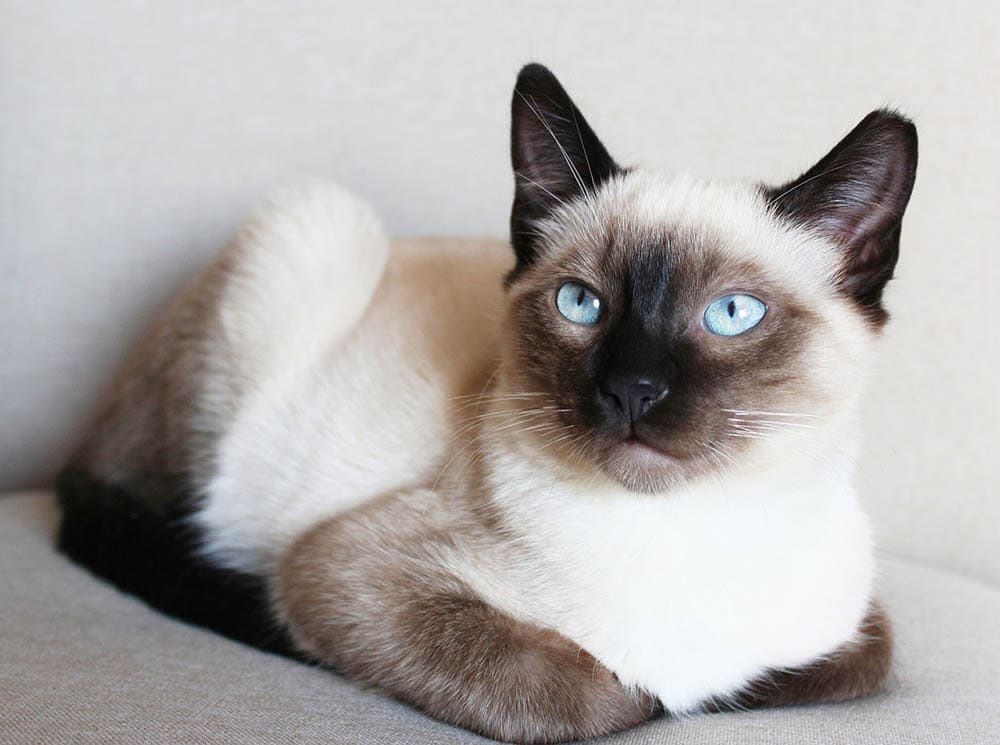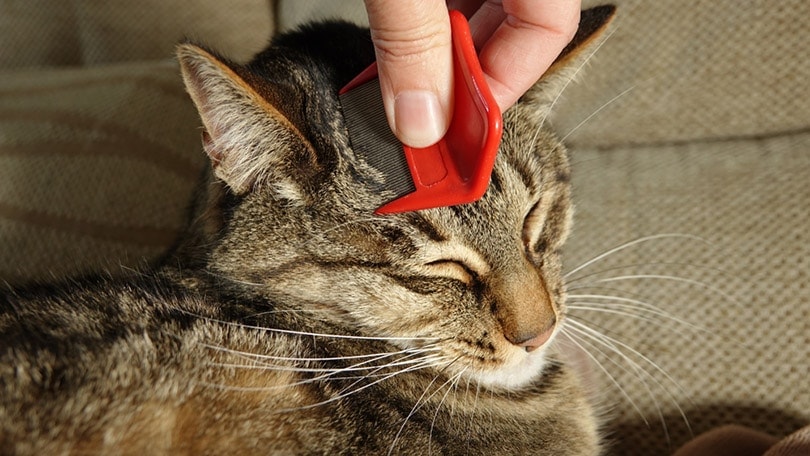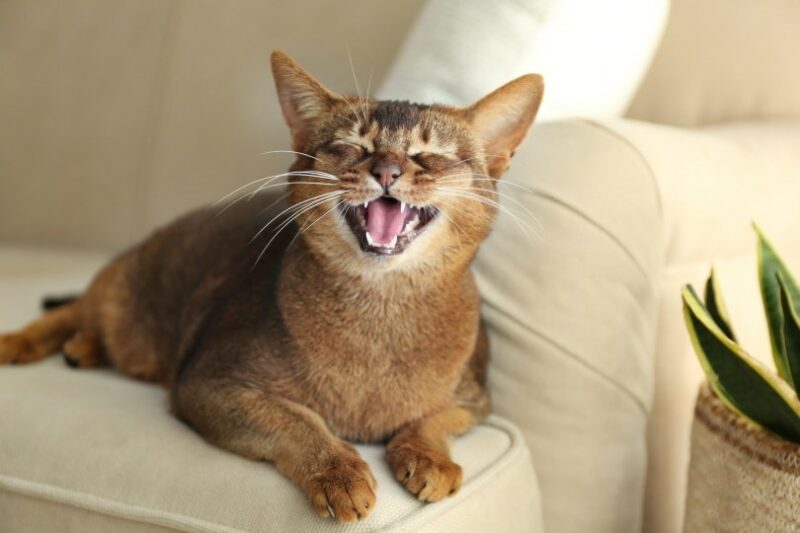Cat is Holding Their Paw Up When Sitting: 8 Vet Approved Reasons Why

Updated on
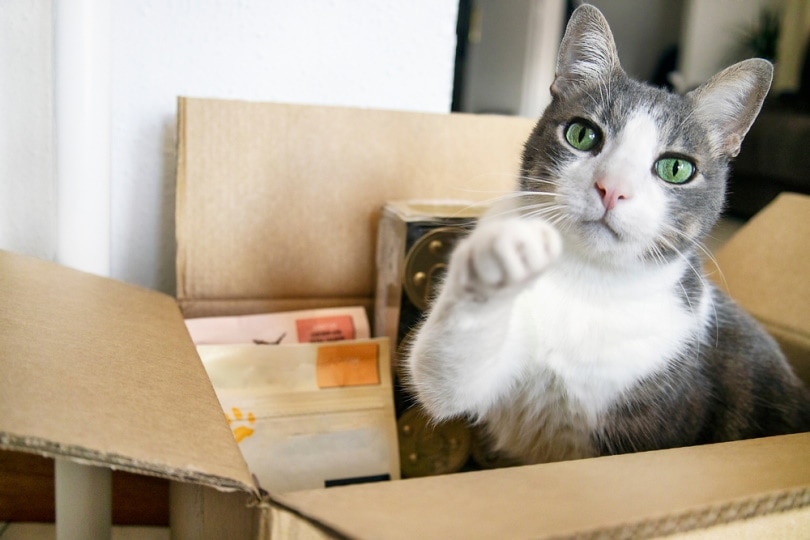
You are probably used to seeing your cuddly buddy act like they’re totally out of their mind. One of the most puzzling antics they could pull in a desperate attempt to communicate is a “paw raise” while seated. Is there an explanation for this weird behavior, or is your charismatic little cat acting cute?
A “paw raise” from a seated position communicates anticipation, curiosity, and potential excitement. Depending on your cat’s overall emotional state and other body language signals, they could be soliciting your attention. Perhaps they desire a treat, would fancy a quick petting session, or want to smack you in the face.
Cats are as intelligent and lovable as they are quirky and mysterious. It is their propensity for weirdness that gets you in fits of laughter. If you are curious why your chilled cat awkwardly has their paw in the air, read on to learn eight possible reasons.
Top 8 Reasons Your Cat is Holding Their Paw Up When Sitting
1. Your Cat Is Injured or in Pain
Often, a paw-up from your furry friend is a cute gesture. However, your cat could also extend their paw without waking up from their position to show that they’re hurt. If you notice signs of stress, pain, or discomfort, gently take the foot and examine it for cuts, soreness, swelling, discharge, redness, or other forms of injury.
If you don’t see a visible wound, get your cat’s favorite treat and encourage them to take a few steps toward you. Check whether they pounce on the treat with their usual energy or limp toward you. If you notice the latter, or you’re just not sure, it’s time for a visit to your vet.
Be careful when examining their paw on your own, though, as if they are in pain and you touch a sore spot, they may scratch or bite.
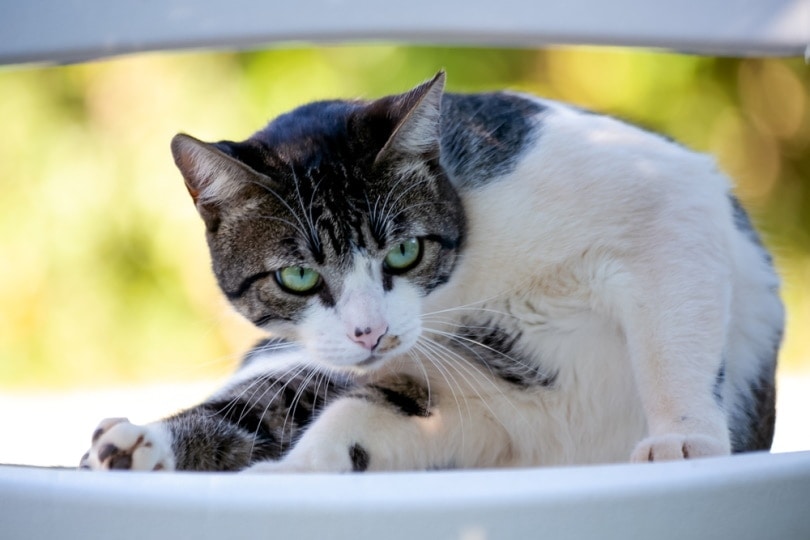
2. Your Cat is Stretching
Let’s continue with the other simplest, most logical explanation behind your cat outstretching a paw when sitting. If your cat is relaxed, happy, and content, they may fully extend a paw to stretch their muscles. They often do this as part of a full body stretch, extending both front or back legs at the same time. While it could accidentally stretch the foot in your direction, it doesn’t necessarily mean they want your attention.
The lazy couch potato may be too comfortable sitting to stand up and stretch their entire body. If they switch back to their usual aloof nature after they raise their paw, your cat likely does not need your attention.
3. A Call for Your Attention
If your cat is holding their paw up when sitting next to you, this is generally a sign of anticipation. They may be asking you to hurry up and grant them what they want. Depending on the context, your cat could be asking for the following things.
- Food, treats, or objects
- Your attention
- Your affection
- Wanting to be let out
If you are focused on something else, such as your favorite TV show, your cuddly buddy seated next to you could raise their paw to get your attention. Those glimmer eyes are telling you to pass another yummy treat. It may also be that your cat wants you to play with them or give them a good round of petting and stroking.
Often, your cat will relax once their wish is granted. If not, they may stretch their paw again and bat you to get your full attention. Think of the outstretched paw as a polite way of getting you to focus on them without being too pushy or getting on your nerves with excessive vocalization.
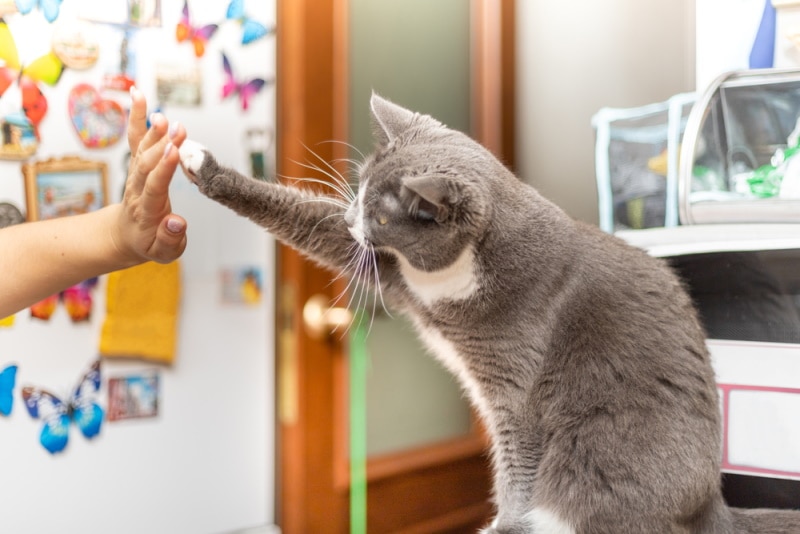
4. Your Cat Is Showing Affection
Cats show affection for their owners in many different ways. Contrary to popular belief, a raised paw is not always a sign that your cat wants something. However, they may want you to see their sweet gesture.
For instance, they could choose to sit next to you to show that they enjoy your company and trust you. If they cannot get close enough or don’t want you to get physically affectionate, they may stretch out one paw to shorten the distance between you.
Another possible explanation for a raised paw from a seated position is that your cat wants to mark you with their scent. Cats have scent glands on the pads of their paws. If your pet dabs you repeatedly, the affectionate gesture indicates that you are part of their family.
5. Your Cat Is Playing “Copycat”
While cats have a ‘bad’ reputation of being solitary and antisocial, they are curious and always keen on exploring their surroundings. Cats seem to be among the few creatures that can imitate the actions of their owners.
These animals are impressive observational learners. They may mimic their owners or other pets, but we still don’t know why. It may be because they have learned that the behavior gets rewarded with treats. More scientific research is required into understanding this behavioral model and what influences it. Showing that they are tuned to your behaviors and actions also aids bonding and communication.
If your cat raises a paw when you approach them, they may be giving you a high five. Maybe they have seen you do this with your child and dog and want to try it! But before you get excited about this prospect, just be aware there are only a few rare reports of cats copying human behavior to date, and they had training beforehand. If you find your cat may be doing it, get in touch and share your experiences. We’d love to hear about it.
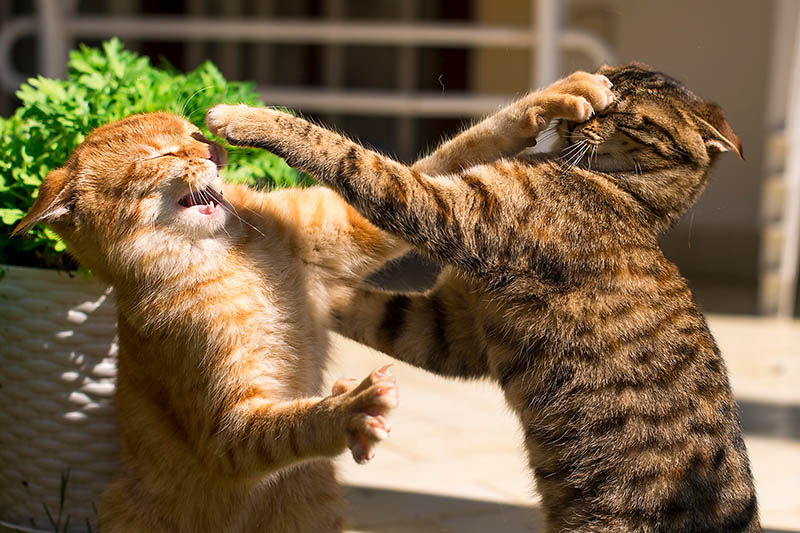
6. Your Cat Is Agitated and Intends to Strike
If it’s not your kitty’s usual time for a treat and you are not munching something that looks tasty, a raised paw is likely not a sign that they want a treat.
If your cat loves your company but is not a great fan of physical displays of affection, giving them more than a few pats on their back can get them anxious or agitated. In this case, the paw raise means they’ve had enough of your affection and want some personal space. Failing to stop could earn you a paw smack in the face.
7. Your Cat Wants to Pounce on Something
If your cat is perching on an area that gives them a good vantage point, staying seated with a raised paw could mean they have spotted potential prey. Your cat will also open their eyes wide with their ears pointed up while calculating their next move.
While your furry friend may generally seem absent-minded, as if they’re gazing into the abyss, the paw gesture shows they’re eager, excited, and ready to act.
You’ll also notice other body language signals showing your feline’s natural predatory instincts are on fire.
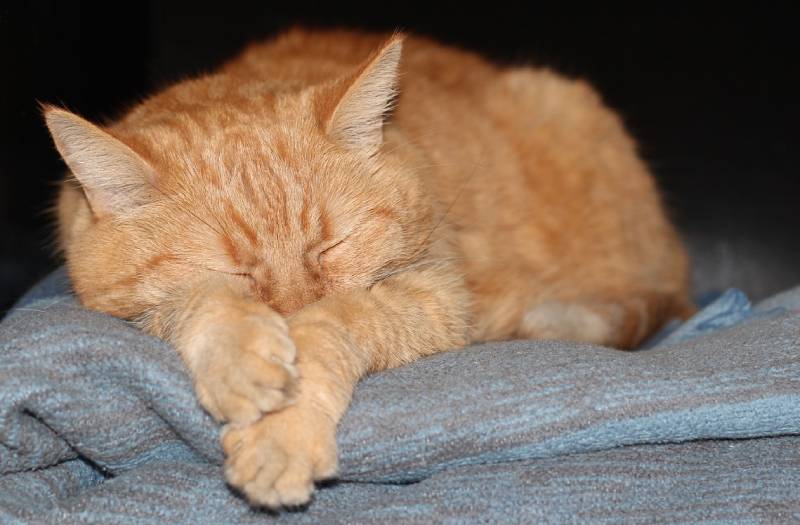
8. They’re Preparing to Take a Nap
Kneading is an instinctual behavior mastered during kittenhood. It is meant to press the mother’s breasts to speed up milk dispensation. Generally, kneading indicates contentment, whether done by a kitten or an adult cat.
A happy and content cat can move their paws to stamp you gently. Other body language signals you may notice include extreme purring. Often, kneading starts with one paw up before your cat goes into full feet stamping action.
Cats knead for various reasons, including marking their territory and leaving their scent on things or people they “own.” Your furry friend could also be ensuring the ground is soft enough to provide a comfortable sleeping place.
Frequently Asked Questions (FAQs)
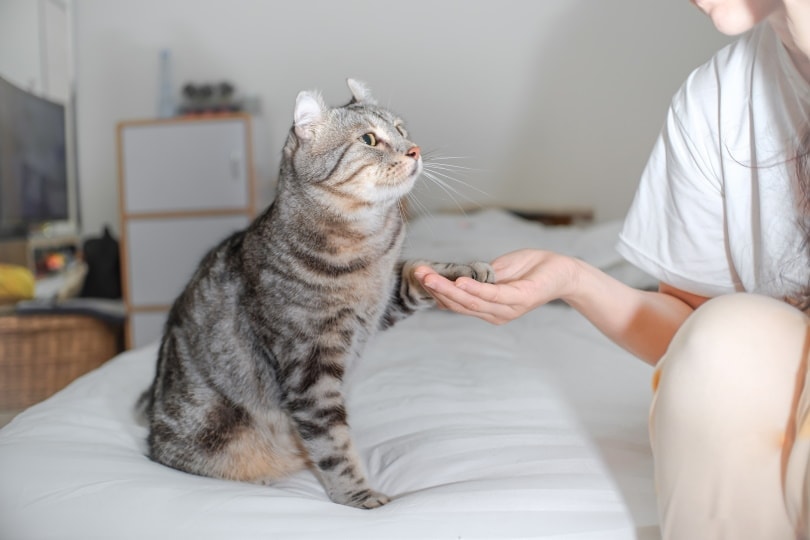
Is it typical for a cat to sit with one paw raised?
It’s not unusual for cats to sit with a raised paw, but it’s not necessarily typical for every cat. While they often make paw gestures to communicate, you could also notice your cat raising their paw when you are not close. Paw gestures should not get you freaked out, particularly if your cat calms down once you offer attention, affection, or a treat.
Should I worry if my cat keeps raising its paw at random things?
Cats can act a little nuts for no apparent reason. However, there is cause for alarm if your cat keeps pawing at random things. If they’re also knocking things over and are excessively vocal, they could be anxious, stressed, or frustrated and trying to vent. Pawing only on hard surfaces may mean their nails are too long and they want to file them. Talk to your vet if the awkward behavior persists, if your cat is always lifting the same paw, or if they are limping, have overgrown nails, or have any swelling, redness, wounds, or discharge.
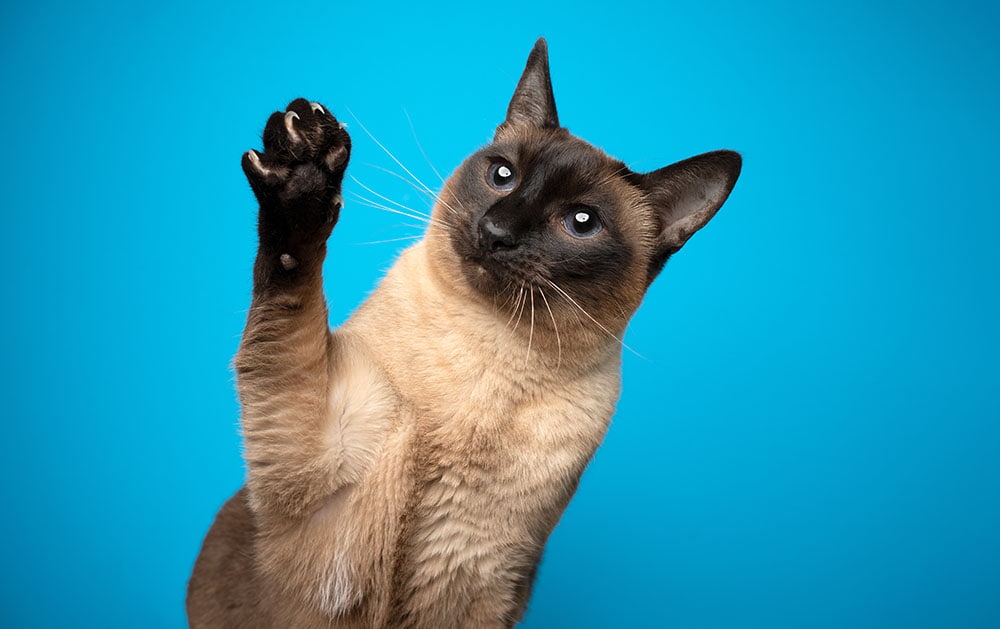
Why does my cat raise one paw to touch my face?
If your happy and relaxed feline raises a paw to touch your face, this is likely a show of affection. They may want to mark you with their scent or show a cute gesture to grab your attention. Try petting them gently or offering a treat. If this does not work, prepare for at least 20 minutes of playtime. Sometimes, they may also be trying to tell you that they have had enough bonding and need a break.
- You might be interested: Why Does Your Cat Reach Their Paw Out to You?
Final Thoughts
Sometimes, cats act weird, and it can be challenging to decipher what they are trying to communicate. They can run around the house like maniacs, freak out for no reason, or wake you to some midnight madness of knocking things off the edges of tables. While it is impossible to understand your oddball’s actions fully, you can never go wrong by checking their body language.
Often, a raised paw is not a cause for alarm, and you don’t need to rush to the vet. But if you notice your cat limping, seeming stressed and not themself, or licking their paw excessively with any sores, wounds, swelling, discharge, or bad smells, it’s time to get them checked out by your vet.
Based on your pet’s body language, you can tell whether they want a high five or a bite of what you are eating. Showing that you understand your cat’s language can help strengthen the bond between you.
Featured Image Credit: AssiaPix, Shutterstock



